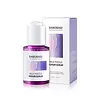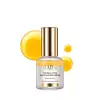What's inside
What's inside
 Key Ingredients
Key Ingredients

 Benefits
Benefits

 Concerns
Concerns

No concerns
 Ingredients Side-by-side
Ingredients Side-by-side

Arctium Lappa Root Extract
Skin ConditioningGlycerin
Humectant1,2-Hexanediol
Skin ConditioningDipropylene Glycol
HumectantButylene Glycol
HumectantDiethoxyethyl Succinate
SolventNiacinamide
SmoothingBetaine
HumectantCentella Asiatica Extract
CleansingMadecassoside
AntioxidantEchium Plantagineum Seed Oil
Skin ConditioningHelianthus Annuus Seed Oil Unsaponifiables
EmollientCardiospermum Halicacabum Flower/Leaf/Vine Extract
Skin ConditioningAcetyl Hexapeptide-8
HumectantCopper Tripeptide-1
Skin ConditioningPanthenol
Skin ConditioningAdenosine
Skin ConditioningEthylhexylglycerin
Skin ConditioningDisodium EDTA
Hydroxyacetophenone
AntioxidantWater
Skin ConditioningXanthan Gum
EmulsifyingCarbomer
Emulsion StabilisingHydrogenated Lecithin
EmulsifyingOctyldodeceth-16
EmulsifyingTromethamine
BufferingOctyldodecanol
EmollientTocopherol
AntioxidantSilybum Marianum Seed Extract
Skin ConditioningArctium Lappa Root Extract, Glycerin, 1,2-Hexanediol, Dipropylene Glycol, Butylene Glycol, Diethoxyethyl Succinate, Niacinamide, Betaine, Centella Asiatica Extract, Madecassoside, Echium Plantagineum Seed Oil, Helianthus Annuus Seed Oil Unsaponifiables, Cardiospermum Halicacabum Flower/Leaf/Vine Extract, Acetyl Hexapeptide-8, Copper Tripeptide-1, Panthenol, Adenosine, Ethylhexylglycerin, Disodium EDTA, Hydroxyacetophenone, Water, Xanthan Gum, Carbomer, Hydrogenated Lecithin, Octyldodeceth-16, Tromethamine, Octyldodecanol, Tocopherol, Silybum Marianum Seed Extract
Water
Skin ConditioningHelianthus Annuus Seed Oil
EmollientButylene Glycol
HumectantDipropylene Glycol
Humectant1,2-Hexanediol
Skin ConditioningMacadamia Ternifolia Seed Oil
EmollientTuber Magnatum Extract
Skin ConditioningTocopherol
AntioxidantCaprylic/Capric Triglyceride
MaskingCamellia Japonica Seed Oil
EmollientOenothera Biennis Oil
EmollientOlea Europaea Fruit Oil
MaskingPersea Gratissima Oil
Skin ConditioningLimnanthes Alba Seed Oil
Skin ConditioningArginine
MaskingCarbomer
Emulsion StabilisingBetaine
HumectantPanthenol
Skin ConditioningTocopheryl Acetate
AntioxidantBetula Platyphylla Japonica Juice
Skin ConditioningRosa Centifolia Flower Water
Skin ConditioningEthylhexylglycerin
Skin ConditioningGlycerin
HumectantGlycine Soja Oil
EmollientDipotassium Glycyrrhizate
HumectantDisodium EDTA
Hippophae Rhamnoides Fruit Oil
Skin ProtectingHydroxyethyl Urea
HumectantAloe Barbadensis Leaf Extract
EmollientAdenosine
Skin ConditioningPentaerythrityl Tetra-Di-T-Butyl Hydroxyhydrocinnamate
AntioxidantBifida Ferment Lysate
Skin ConditioningHibiscus Esculentus Fruit Extract
Skin ConditioningHydrolyzed Hyaluronic Acid
HumectantSodium Hyaluronate
HumectantSodium Palmitoyl Proline
Skin ConditioningBixa Orellana Seed Oil
EmollientOcimum Basilicum Flower/Leaf/Stem Extract
TonicChamomilla Recutita Flower Extract
MaskingHibiscus Sabdariffa Flower Extract
Skin ConditioningLavandula Angustifolia Flower Extract
CleansingMelissa Officinalis Leaf Extract
Skin ConditioningMentha Piperita Leaf Extract
Skin ConditioningMentha Rotundifolia Leaf Extract
TonicMonarda Didyma Leaf Extract
Skin ConditioningRosa Centifolia Flower Extract
AstringentRosmarinus Officinalis Leaf Extract
AntimicrobialSalvia Officinalis Leaf Extract
CleansingCentella Asiatica Extract
CleansingPotassium Sorbate
PreservativeBellis Perennis Flower Extract
Skin ConditioningChlorphenesin
AntimicrobialFreesia Refracta Extract
Skin ConditioningHouttuynia Cordata Extract
Skin ConditioningLeontopodium Alpinum Extract
Skin ConditioningLilium Candidum Flower Extract
Skin ConditioningMorus Alba Bark Extract
Skin ConditioningNelumbo Nucifera Flower Extract
Skin ConditioningPanax Ginseng Root Extract
EmollientSaussurea Involucrata Extract
HumectantAvena Sativa Kernel Extract
AbrasiveSalvia Hispanica Seed Extract
EmollientNymphaea Alba Flower Extract
Skin ConditioningParfum
MaskingWater, Helianthus Annuus Seed Oil, Butylene Glycol, Dipropylene Glycol, 1,2-Hexanediol, Macadamia Ternifolia Seed Oil, Tuber Magnatum Extract, Tocopherol, Caprylic/Capric Triglyceride, Camellia Japonica Seed Oil, Oenothera Biennis Oil, Olea Europaea Fruit Oil, Persea Gratissima Oil, Limnanthes Alba Seed Oil, Arginine, Carbomer, Betaine, Panthenol, Tocopheryl Acetate, Betula Platyphylla Japonica Juice, Rosa Centifolia Flower Water, Ethylhexylglycerin, Glycerin, Glycine Soja Oil, Dipotassium Glycyrrhizate, Disodium EDTA, Hippophae Rhamnoides Fruit Oil, Hydroxyethyl Urea, Aloe Barbadensis Leaf Extract, Adenosine, Pentaerythrityl Tetra-Di-T-Butyl Hydroxyhydrocinnamate, Bifida Ferment Lysate, Hibiscus Esculentus Fruit Extract, Hydrolyzed Hyaluronic Acid, Sodium Hyaluronate, Sodium Palmitoyl Proline, Bixa Orellana Seed Oil, Ocimum Basilicum Flower/Leaf/Stem Extract, Chamomilla Recutita Flower Extract, Hibiscus Sabdariffa Flower Extract, Lavandula Angustifolia Flower Extract, Melissa Officinalis Leaf Extract, Mentha Piperita Leaf Extract, Mentha Rotundifolia Leaf Extract, Monarda Didyma Leaf Extract, Rosa Centifolia Flower Extract, Rosmarinus Officinalis Leaf Extract, Salvia Officinalis Leaf Extract, Centella Asiatica Extract, Potassium Sorbate, Bellis Perennis Flower Extract, Chlorphenesin, Freesia Refracta Extract, Houttuynia Cordata Extract, Leontopodium Alpinum Extract, Lilium Candidum Flower Extract, Morus Alba Bark Extract, Nelumbo Nucifera Flower Extract, Panax Ginseng Root Extract, Saussurea Involucrata Extract, Avena Sativa Kernel Extract, Salvia Hispanica Seed Extract, Nymphaea Alba Flower Extract, Parfum
 Reviews
Reviews

Ingredients Explained
These ingredients are found in both products.
Ingredients higher up in an ingredient list are typically present in a larger amount.
1,2-Hexanediol is a synthetic liquid and another multi-functional powerhouse.
It is a:
- Humectant, drawing moisture into the skin
- Emollient, helping to soften skin
- Solvent, dispersing and stabilizing formulas
- Preservative booster, enhancing the antimicrobial activity of other preservatives
Adenosine is in every living organism. It is one of four components in nucleic acids that helps store our DNA.
Adenosine has many benefits when used. These benefits include hydrating the skin, smoothing skin, and reducing wrinkles. Once applied, adenosine increases collagen production. It also helps with improving firmness and tissue repair.
Studies have found adenosine may also help with wound healing.
In skincare products, Adenosine is usually derived from yeast.
Learn more about AdenosineBetaine is a common humectant (a substance that promotes retention of moisture). It's known to be gentle on the skin and can help balance hydration.
This ingredient is best for improving hydration and soothing irritated skin. Studies also show it helps even out skin tone.
Fun fact: Betaine is naturally created in the skin and body. The kind found within cosmetic products can be either plant-derived or synthetic.
Another name for betaine is trimethylglycine.
Learn more about BetaineButylene Glycol (or BG) is used within cosmetic products for a few different reasons:
Overall, Butylene Glycol is a safe and well-rounded ingredient that works well with other ingredients.
Though this ingredient works well with most skin types, some people with sensitive skin may experience a reaction such as allergic rashes, closed comedones, or itchiness.
Learn more about Butylene GlycolCarbomer is a polymer of acrylic acid. Its main role is to create a gel consistency.
A high amount of carbomer can cause pilling or balling up of products. Don't worry, most products contain 1% or less of carbomer.
Centella Asiatica Extract (Centella) is derived from an herb native to Southeast Asia. It is famous for its anti-inflammatory and soothing properties.
Centella is rich in antioxidants and amino acids, such as Madecassic Acid and Asiaticoside.
Studies show the compounds in centella help with:
The combination of all these properties makes centella effective at soothing, hydrating, and protecting the skin.
Other great components of centella include Vitamin A, vitamin C, several B vitamins, and Asiatic Acid.
Fun fact: Centella has been used as a medicine and in food for many centuries. As a medicine, it is used to treat burns, scratches, and wounds.
Learn more about Centella Asiatica ExtractDipropylene Glycol is a synthetically created humectant, stabilizer, and solvent.
This ingredient helps:
Dipropylene glycol is technically an alcohol, but it belongs to the glycol family (often considered part of the ‘good’ alcohols). This means it is hydrating and gentle on skin unlike drying solvent alcohols like denatured alcohol.
As a masking agent, Dipropylene Glycol can be used to cover the smell of other ingredients. However, it does not have a scent.
Studies show Dipropylene Glycol is considered safe to use in skincare.
Learn more about Dipropylene GlycolDisodium EDTA plays a role in making products more stable by aiding other preservatives.
It is a chelating agent, meaning it neutralizes metal ions that may be found in a product.
Disodium EDTA is a salt of edetic acid and is found to be safe in cosmetic ingredients.
Learn more about Disodium EDTAEthylhexylglycerin (we can't pronounce this either) is commonly used as a preservative and skin softener. It is derived from glyceryl.
You might see Ethylhexylglycerin often paired with other preservatives such as phenoxyethanol. Ethylhexylglycerin has been found to increase the effectiveness of these other preservatives.
Glycerin is already naturally found in your skin. It helps moisturize and protect your skin.
A study from 2016 found glycerin to be more effective as a humectant than AHAs and hyaluronic acid.
As a humectant, it helps the skin stay hydrated by pulling moisture to your skin. The low molecular weight of glycerin allows it to pull moisture into the deeper layers of your skin.
Hydrated skin improves your skin barrier; Your skin barrier helps protect against irritants and bacteria.
Glycerin has also been found to have antimicrobial and antiviral properties. Due to these properties, glycerin is often used in wound and burn treatments.
In cosmetics, glycerin is usually derived from plants such as soybean or palm. However, it can also be sourced from animals, such as tallow or animal fat.
This ingredient is organic, colorless, odorless, and non-toxic.
Glycerin is the name for this ingredient in American English. British English uses Glycerol/Glycerine.
Learn more about GlycerinPanthenol is a common ingredient that helps hydrate and soothe the skin. It is found naturally in our skin and hair.
There are two forms of panthenol: D and L.
D-panthenol is also known as dexpanthenol. Most cosmetics use dexpanthenol or a mixture of D and L-panthenol.
Panthenol is famous due to its ability to go deeper into the skin's layers. Using this ingredient has numerous pros (and no cons):
Like hyaluronic acid, panthenol is a humectant. Humectants are able to bind and hold large amounts of water to keep skin hydrated.
This ingredient works well for wound healing. It works by increasing tissue in the wound and helps close open wounds.
Once oxidized, panthenol converts to pantothenic acid. Panthothenic acid is found in all living cells.
This ingredient is also referred to as pro-vitamin B5.
Learn more about PanthenolTocopherol (also known as Vitamin E) is a common antioxidant used to help protect the skin from free-radicals and strengthen the skin barrier. It's also fat soluble - this means our skin is great at absorbing it.
Vitamin E also helps keep your natural skin lipids healthy. Your lipid skin barrier naturally consists of lipids, ceramides, and fatty acids. Vitamin E offers extra protection for your skin’s lipid barrier, keeping your skin healthy and nourished.
Another benefit is a bit of UV protection. Vitamin E helps reduce the damage caused by UVB rays. (It should not replace your sunscreen). Combining it with Vitamin C can decrease sunburned cells and hyperpigmentation after UV exposure.
You might have noticed Vitamin E + C often paired together. This is because it is great at stabilizing Vitamin C. Using the two together helps increase the effectiveness of both ingredients.
There are often claims that Vitamin E can reduce/prevent scarring, but these claims haven't been confirmed by scientific research.
Learn more about TocopherolWater. It's the most common cosmetic ingredient of all. You'll usually see it at the top of ingredient lists, meaning that it makes up the largest part of the product.
So why is it so popular? Water most often acts as a solvent - this means that it helps dissolve other ingredients into the formulation.
You'll also recognize water as that liquid we all need to stay alive. If you see this, drink a glass of water. Stay hydrated!
Learn more about Water